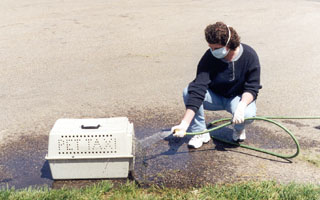
Introduction:
Leptospirosis infections have a higher occurrence in warmer semi-tropical regions, in the late summer and early autumn. Dogs that have access to marshy or muddy areas, ponds, stagnant surface water in low lying areas, and heavily irrigated pastures are more at risk, as the bacteria thrives in these environments.Causative Agent: Leptospirosis is caused by a spiral-shaped bacteria known as a spirochete. There are many strains of Leptospira, and most canine cases are caused by Leptospira canicola and L. icterohaemorrhagiae.
Clinical Signs: Clinical signs vary depending on factors such as age and health of the animal, environmental conditions, and which strain (serovar) of leptospirosis is involved. Generally, large breed adult dogs are affected more frequently, but young dogs are affected more severely. Fever, shivering, wide-spread muscle pain and tenderness may occur first, followed by vomiting, de-hydration, decreased appetite, and increased thirst. Depending on which body systems are affected, other signs may include bleeding (blood in the vomit, stool, nosebleeds, spontaneous bruising), coughing, shortness of breath, icterus (jaundice), and red or weepy eyes.
Diagnosis: The most accurate way of knowing whether leptospirosis is the cause of disease is to run a test called serology. This test requires that paired blood samples be taken over a 1-2 week period. Leptospirosis is difficult to identify in tissue or body fluid samples and difficult to grow in a culture setting. Because of the length of time required to make a truly accurate or definitive diagnosis, and because of the serious nature of the disease, treatment is often begun before the definitive (positive) results are obtained. Routine blood and urine tests are run in order to assess which systems are affected and to help the veterinarian establish a supportive treatment plan.
Treatment: This involves supportive care to correct dehydration and therapy for kidney and liver involvement, along with antibiotics to eliminate Leptospira organisms from the body.
Prevention: Vaccines are available and should be given to puppies and adult dogs that are susceptible or live in areas where leptospirosis is a concern. The vaccines that are currently available do not protect against all serovars (strains) of leptospirosis. It has been recommended that the vaccine be avoided in combination with certain other vaccines (such as canine coronavirus vaccine), and that the vaccine should also be avoided in miniature dachshunds because of their high rate of allergic reactions. Other preventative measures include strict kennel sanitation (especially with regards to infected urine), isolation of infected dogs, rodent control, and limiting access to marshy or muddy ponds, stagnant water, heavily irrigated areas, and wildlife.
Public Health Concerns: Leptospirosis is a "zoonotic" disease, meaning that people can become infected. Caution should be used around any animal suspected of having leptospirosis. Contaminated urine is highly infectious for people and susceptible animals, especially when this urine contacts mucous membrane surfaces or abrasions and cuts. Latex gloves should be worn when handling infected animals or their urine. Protective goggles and masks should be worn when hosing contaminated areas.
